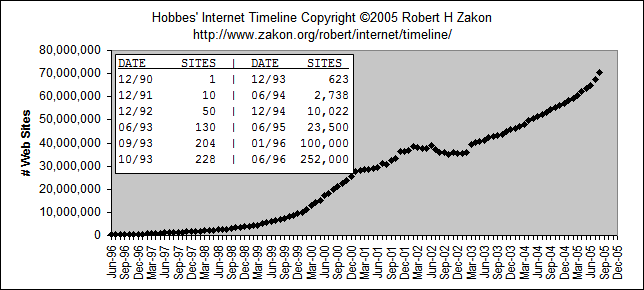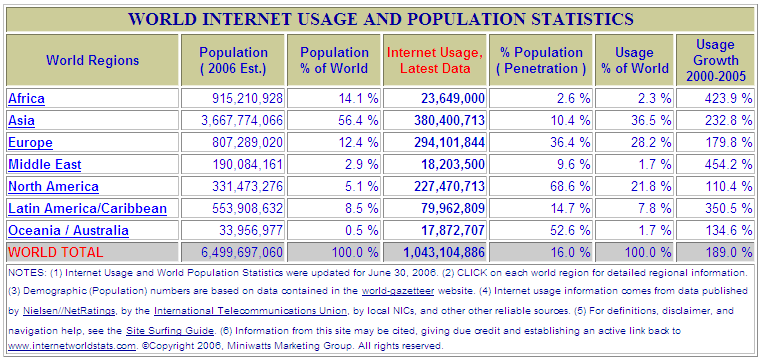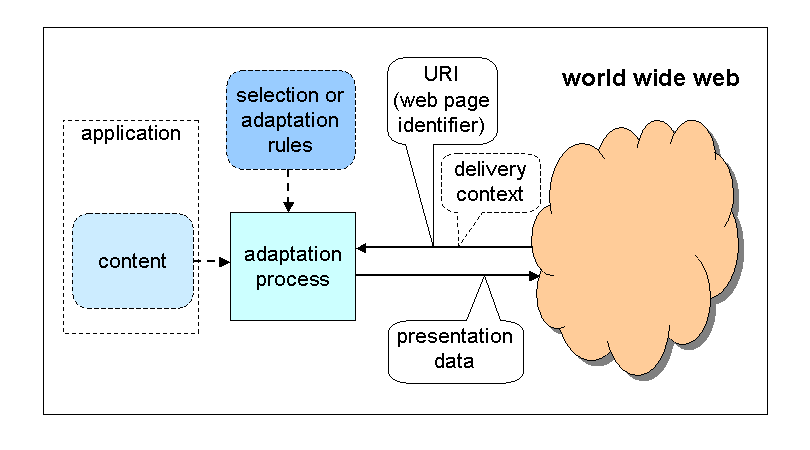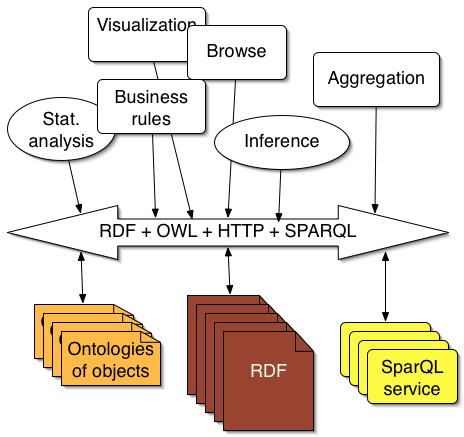Overview

- Growth of the Web
- Value of standards
- World Wide Web Consortium
- Evolution of the Web technology
- Summary of emerging technologies
- Focus on 3 areas which could have a significant impact to you
What Led to the Web's Success?

- Simple architecture - HTTP, URI, HTML
- Networked - value grows with data, services, users
- Extensible - from Web of documents to .. you'll see in a bit
- Tolerant - works with imperfect mark-up, data, links, SW
- Universal - independent of HW, OS, SW, language, ability
- Free / cheap - browsers, information, services
- Simple (and fun) for users - text, graphics, links
- Powerful - for people (and machines)
- Open standards ...
Why are Open Standards Important?
- Cross-application integration
- Avoids vendor lock-in
- … need a particular operating system and/or browser to file
taxes, access health insurance data, …
- Access for all
- Developers, systems, users know what to expect
- Unexpected reuse
- e.g., Web on phones, links are popularity votes, your data is
useful to others
- Open, RF standards = good business
sense ...
- Enable unencumbered implementation of foundational standards
- Enable commerce and communication on top
- Customers / gov't regulations will mandate them
Web Usage and Technologies are Evolving ...
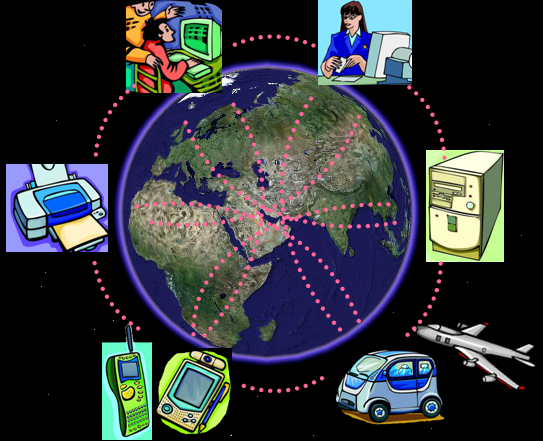
- From a Web of Documents ...
- Toward One Web ...
- ... of Data and Services
- ... on Everything
- ... for Everyone
- -- think Web 2.0, Web as a platform, etc.
Engineering an Interoperable Foundation of the Web
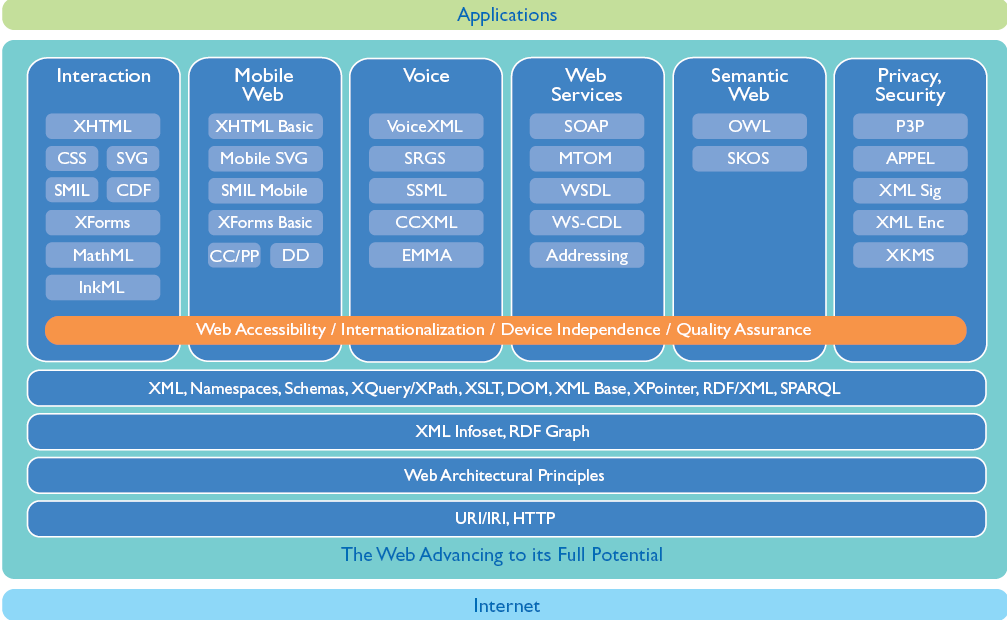
The Real Question
- Q: Which of these are relevant to an "engineering, science and advanced
technology solutions" company?
Leading Edge: Web for Everyone

Why is Web Accessibility Important?

- Use of the Web is spreading rapidly into all areas of society
- Barriers exist on the Web for many types of disabilities
- Millions of people have disabilities that affect access to the Web
- Aging global population will have increasing levels of disabilities
- Some Web sites are required to be accessible (US Regs)
- Web accessibility also has carry-over benefits for other users
Developing a Web
Accessibility Business Case
Web Accessibility is a Cross-Disability Issue
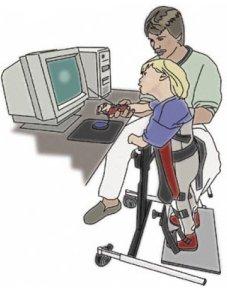
- Visual
- Described graphics or video
- Well marked-up tables or frames
- Keyboard support, screen reader compatibility
- Hearing
- Captioning for audio, supplemental illustration;
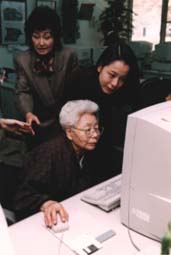
- Physical, Speech:
- Keyboard or single-switch support;
- Alternatives for speech input on voice portals;
- Cognitive, Neurological:
- Consistent navigation, appropriate language level;
- Illustration; no flickering or strobing designs.
Image source: http://www.cedwvu.org/programs/dbtac/hrsabrochure/
Leading Edge: Web on Everything
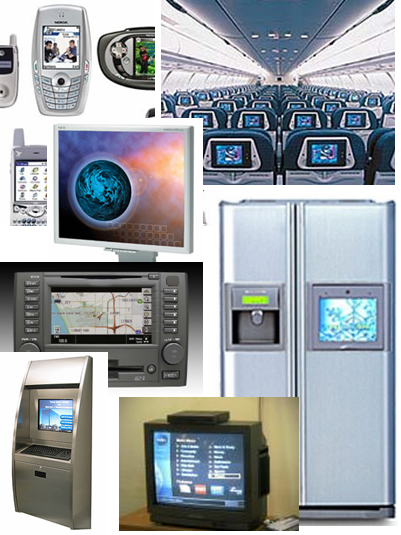
Vision: Web on Everything
One Web ...
... where Web technologies provide the means of accessing and interacting
with content via all devices, including computing, communications,
entertainment, embedded, personal, home, transportation, industrial, health
care, etc. systems
... worldwide.
Why Does a Web on "Everything" Make Sense?
- Web model has proved popular, useful, comfortably familiar
- Users want access to same data and services from more than just
computers
- Content providers want to author data and services only once
- Web technologies are rich and adaptable enough
Why Mobile Devices Should be the Next "Thing"
- In 2005, 1.1 Billion Web-capable mobile phones (= 63% of all
mobiles)

Image source: Steven Pemberton / Data source: Informa
Underachieving Today. Hope for Tomorrow.
- Web access on phones growing, but not high :
- 50% of Web-capable phones are *not* configured to access the
Web
- 24% have tried only once to access a Web site
- There is hope - when the user experience is good, consistent,
etc.
- Nokia Study: 400+ users in UK, Germany, Singapore (advanced
countries)
- Browsing accounts for 63% of data traffic
|
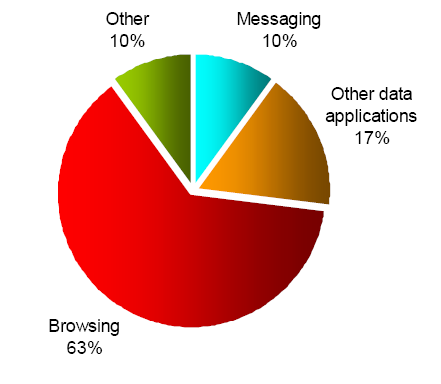 |
Source: Esa Eerola (2005) Nokia, "How Consumers Really Use
Smartphones", MAPOS
05, Vienna
Today, Mobile Web is Expensive for Content Providers
- Phones/browsers/operators require custom Web authoring for acceptable
usability
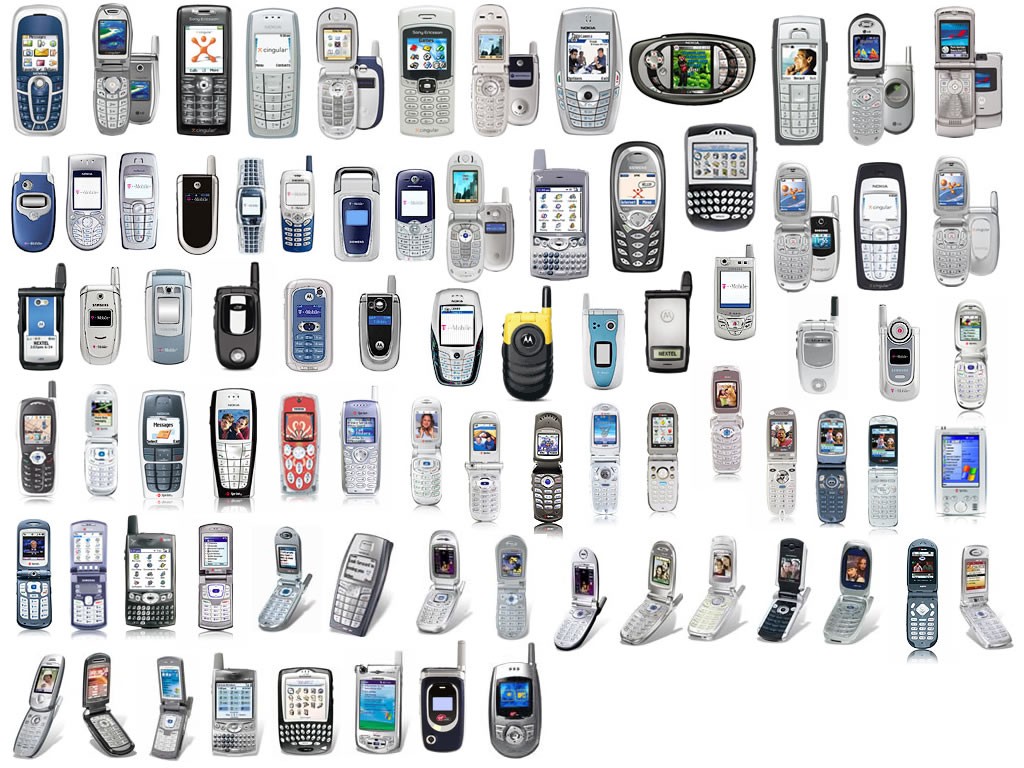
Source: RusselBeattie.com
... Even in Unexpected Places
- Different URIs needed to access automobile service association in
Japan.
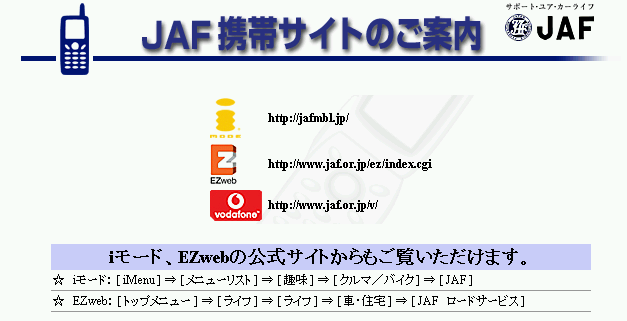
Solution for Web Mobility?

... We can probably do better than this :-)
Follow W3C's Standards Efforts

- "One Web" goal met by
- Making access to the Web on mobile devices as seamless, reliable,
cost-effective, and useful as on desktop/notebook
- One Web ... unfragmented by devices, browsers, operators, content
providers ...
- Key efforts which you would leverage:
- Future: Embedded systems, Ubiquitous Web work under consideration
Leading Edge: Web of Data & Services
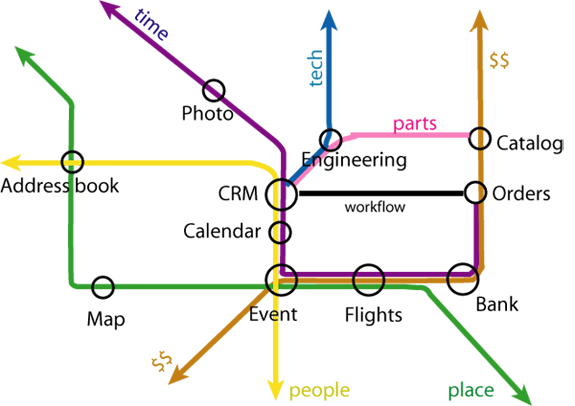
- XML: Binary, Processing Model
- Web
Services: Performance, Addressing, SemWeb Services, Policy
- * Web of Data - Semantic Web: Deployment, Query, Rules, Health Care/Life Sciences, Content Labeling, Geospatial, Multimedia
Semantics, perhaps eGov, etc.
Why Do We Need the Semantic Web?
- Tasks often require combining data on the Web, e.g.:
- Hotel, transport, meeting, personal info come from different
sites
- Searches in disparate digital libraries against your
preferences
- Mining data from biochemical, genetic, pharmaceutical, patient
databases
- Integrating data across the enterprise
- Humans understand how to combine this information ...
- Not always easy (different vocabularies, languages, formats)
- Machines aren't smart enough to understand :-)
Why Can't Computers "Understand"?
Analogy:
What We Say to Dogs
- cartoon ...
- "Stay out of the garbage! Understand, Ginger? Stay out of the
garbage!"
What Dogs Understand
- "... blah blah blah blah GINGER blah blah blah blah ..."
What Computers "Understand"
 |
" ... blah
blah <a
href=http://www.xwz.com/foo.html>.text-link.</a> blah blah . . . ."* |
- Computers must "understand" more:
- Not human concept of "understanding"
- Just useful machine processing, for example, capturing the nature
of
- the "link-text" object
- the thing at the other end of the link
("http://www.xwz.com/foo.html")
- the relationship between the two (why are they linked?)
--
* where <a
href=...> is HTML for a "link"
Toward Processable Search Semantics
Google:
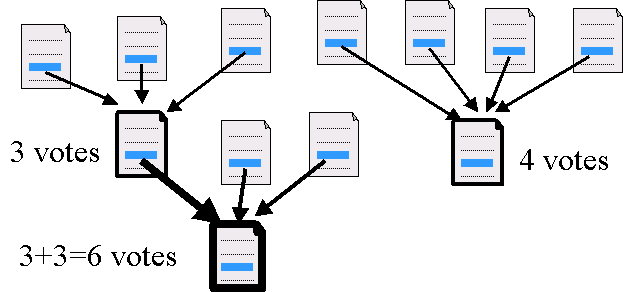
- Web links are machine processable
- Minimal semantics assumed: "This" refers to "that" = popularity
- Amazing results from minimal semantics
What if Web pages had more semantics?
(See Article by
Bijan Parsia)
Ways to Enable Machine Processing
Smarter Machines
- Teach computers to infer the meaning of Web data
- Natural language, image recognition, etc.
- ... this is the Artificial Intelligence approach
Smarter Data
- Make data easier for machines to find, access and process
- Express data and meaning in standard machine-readable format
- Support decentralized definition and management, across the
network
- ... this is the Semantic Web approach
Semantic Web: Data on the Web
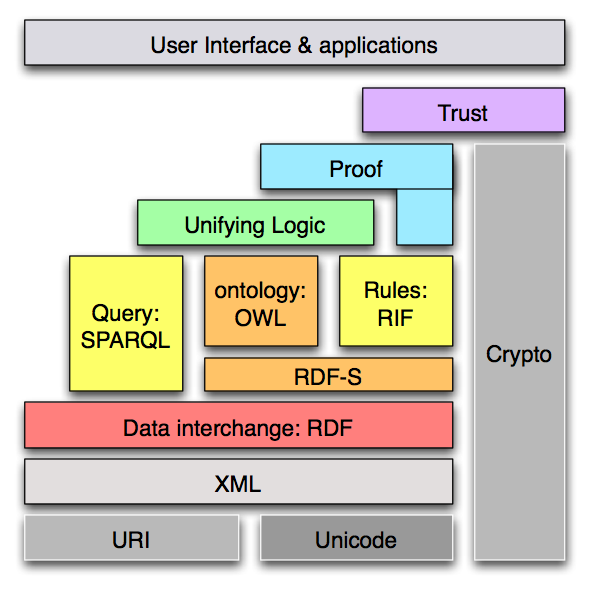 |
Machine-processable, global Web standards:
- Assigning unambiguous names (URI)
- Expressing data, including metadata (RDF)
- Capturing ontologies (OWL)
|
Heart of the Semantic Web
- Semantic Web's Resource Description Framework: a W3C standard (Primer)
- Statements linking data so as to describe things (concepts,
objects, etc.)
- RDF : Data :: HTML link : Documents
- Descriptive statements expressed as triples:
- (Subject, Predicate, Object) or (Subject, Property,
Value)

- Most useful, Web-wise, when these are URIs, e.g. for this presentation:
Most of the Current Web
- Minimal machine-processable information -- dumb links
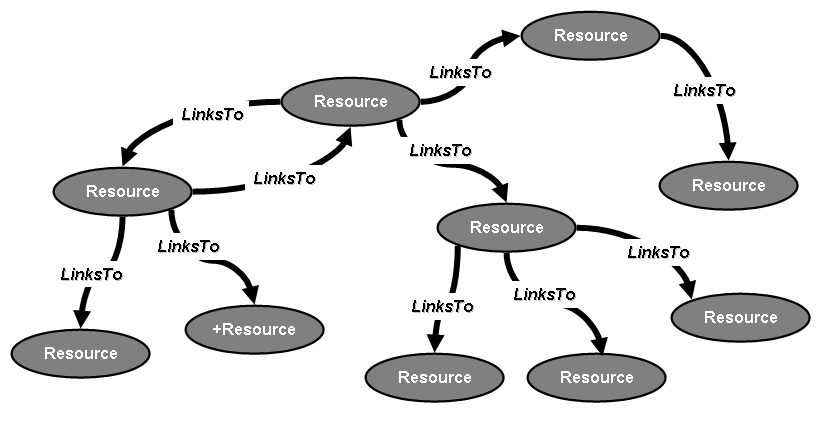
Semantic Web: "Smarter" Resources and Links
- More machine-processable information: data connected by
relationships
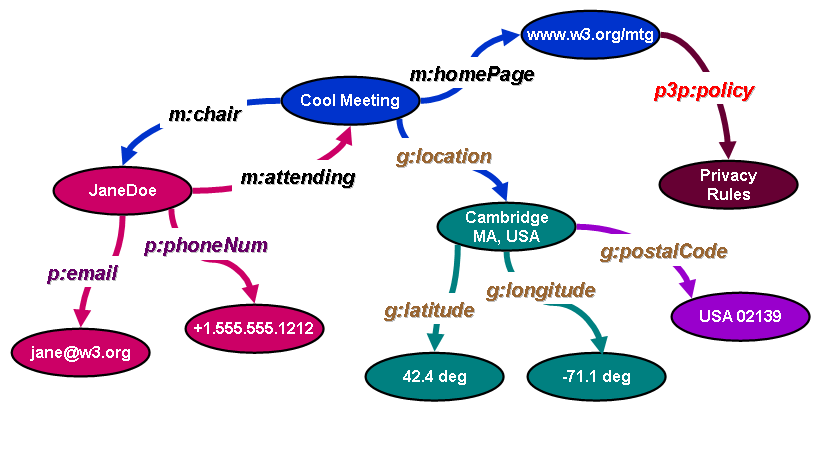
___
[ellipses = resources; color = one data
source; x: = one ontology]
(see also more detailed example related to book
searching and selling)
Enterprise Integration Today
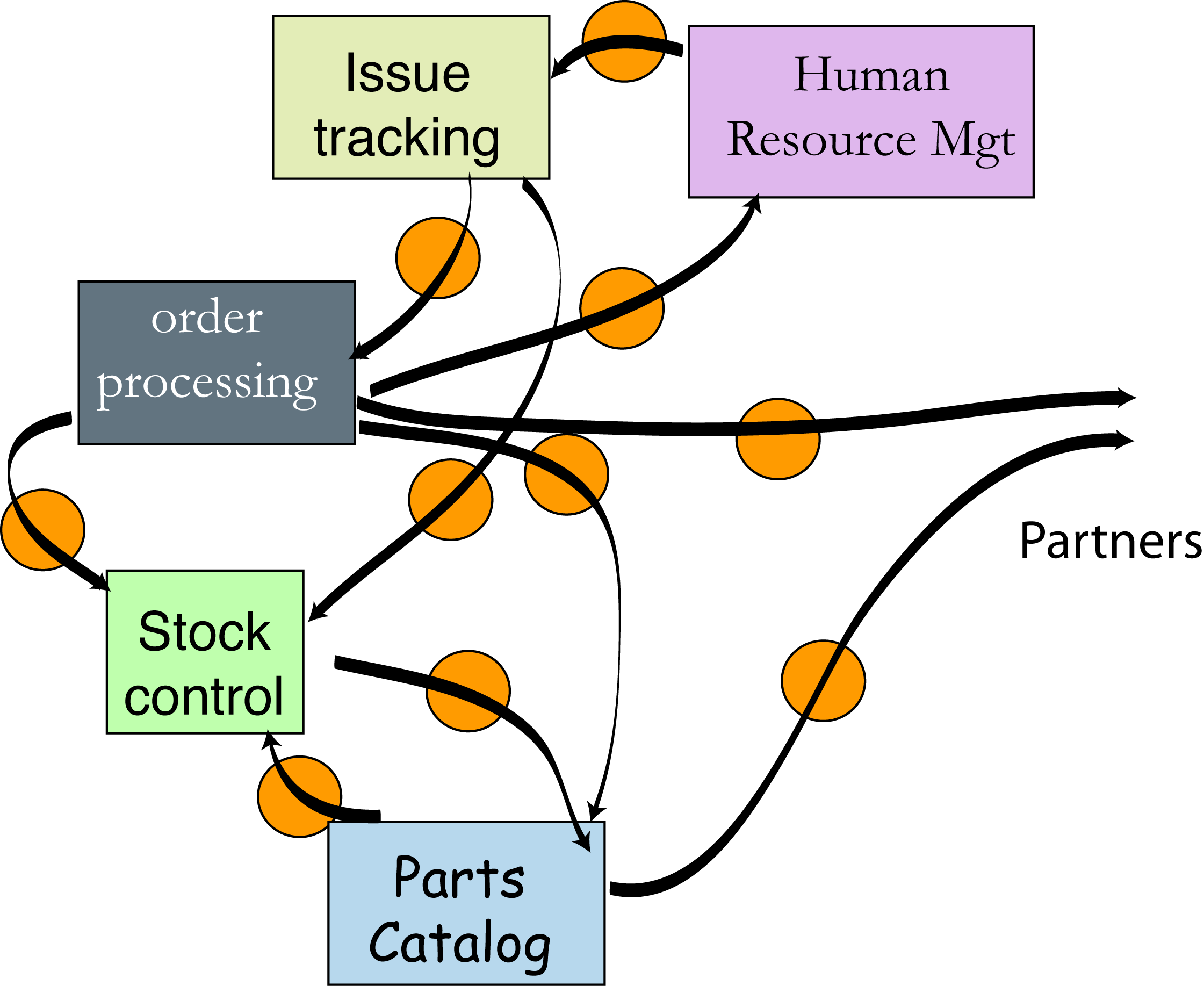
Enterprise Integration on the "RDF Bus"
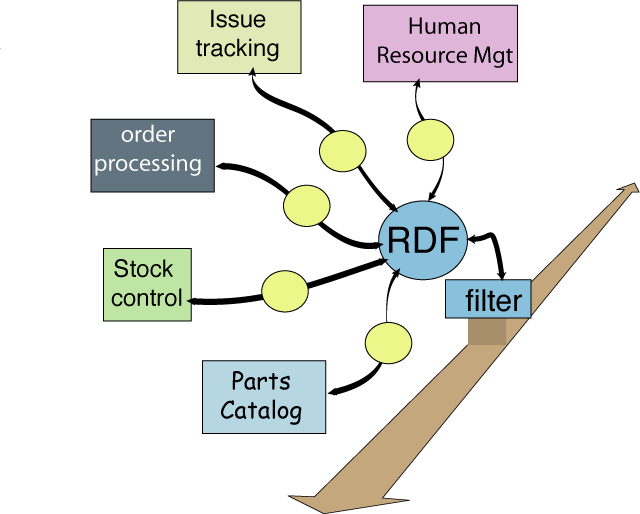
Applications Connected by Concepts

Getting Familiar with the Semantic Web
- See
more detailed tutorial*
- Research groups (e.g., MIT/DIG, UMD, UBristol, DARPA/DAML, etc.)
- Commercial initiatives (HP,
IBM, Oracle,
Nokia, etc.)
- Conferences (e.g., ISWC, SemTech, etc.)
- Follow
W3C's work to drive incubation and standardization
- Explore tools
* Requires SVG viewer (Firefox, Opera, Adobe plug-in)
Timing Strawman
- 2006. Strategic planning. Have your data modelled.
- 2007. Build added value on top of your
organization's data web:
- Build SemWeb wrappers around a few
databases
- Integrate disparate datasets to solve a few unsolved problems
- Offer filtered SemWeb data to partners,
customers
- 2008. Customers, partners demand SemWeb data. More tools available.
- 2009. Build new applications on top of SemWeb base.
- 2011. Replace legacy systems with SemWeb native systems.
Killer apps (or even failures) could radically change the
timeline.
Summary
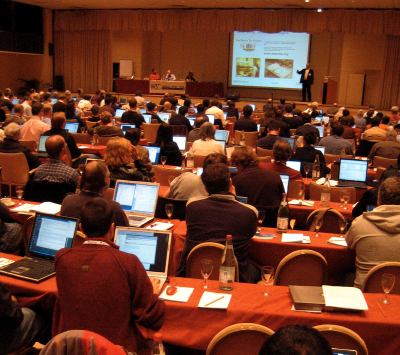
- Evolution toward one Web ...
- of Data and Services, on
Everything, for Everyone
- Strong business case for
- Understanding emerging standards
- Implementing standards as they appear likely
- Participating in standards orgs supports both of these
- A good resource ...

http://www.w3.org/
Who are W3C's Members?
"Third-class companies make products; second-class companies
develop technology; first-class companies set standards."
- W3C's Members includes
...
- most of the world's leading IT companies
- other large and small companies
- academic and research institutions
- government agencies
- non-profit organizations
- ... which are ...
- developing Web-based products
- using Web technologies
- conducting research on the Web
- developing specifications built upon W3C's work
* popular saying in Chinese business and
government, from "China’s Post-WTO
Technology Policy: Standards, Software and the Changing Nature of
Techno-Nationalism", by Richard P.
Suttmeier and Yao Xiangkui.
Full-fee Members (Jul
2006)




















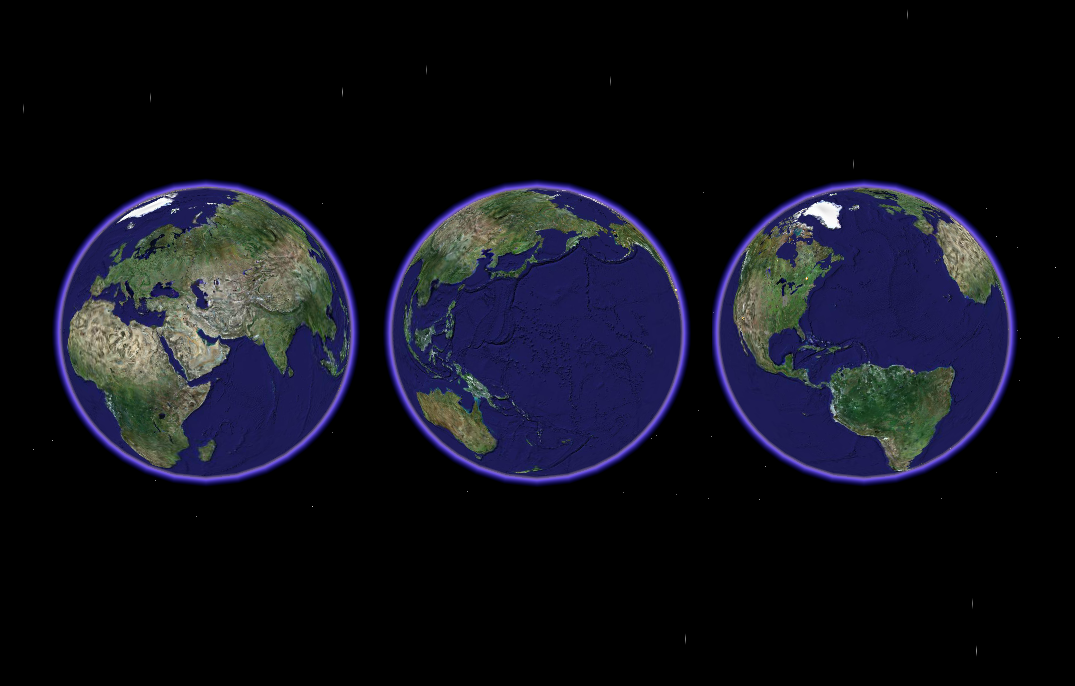
![]()
